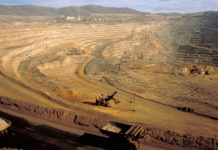
[miningmx.com] – UK gold exploration and development companies have had a week to forget with London’s intrepid hitting 52-week lows as investors baulk at the thought of risking capital in new production.
Amara Mining, Avocet Mining, Hummingbird Resources hit one-year lows in the last seven days and were joined by Toronto-listed junior, Teranga Gold Corporation. One yearly market cap declines are in the sixty to eighty percent region.
John McGloin, chairman of Amara Mining, said it was now cheaper to buy production than build it. His firm’s long-standing Baomahun venture in Sierra Leone is estimated to cost $151m if equipment is leased. Compare that to the $21m (£14m) and $140m (C$148m) at which Hummingbird and Teranga are valued, respectively.
“It’s an ideal market to pick assets up and build a mid-tier gold company,” said McGloin in an interview following the publication of Amara’s bankable feasibility study on Boamahun – the reception of which was mixed in London.
Roger Bade, an analyst for Whitman Howard, asked whether the project was “worth the effort” while Investec Securities said the study was “not an encouraging outcome”. Both take the current gold price as their prompt.
Amara has based its economic assumptions on a gold price of $1,350/oz which yields a post-tax net present value of $127m. Applying the risk of a much lower gold price, the NPV slides to $41m at $1,200/oz, according to Investec.
GMP Securities observes that in light of market conditions “Baomahun clearly has to be seen as an option of a future recovery of capital markets and gold prices”. (Other stockbrokers – Numis Securities – said the feasibility study was “positive”).
Unfortunately, Amara Mining is not an exchange traded product, but a real company building a real mine requiring capital today.
McGloin said financing Baomahun was not mission impossible; the firm’s partnership with Samsung C&T Corporation could provide cornerstone finance whilst attracting a strategic investor on a joint venture basis is also been studied.
“Now that we’ve got the feasibility out we can start conversations with Samsung and other strategic investors. We certainly won’t rush out and issue shares. We can’t. That would be highly dilutive,” said McGloin.
Amara has also promised to turn the screws on the project in an effort to lower its cash costs such as the prospect of an owner-operating model, accessing gold from underground mining, and using hydroelectric power.
It’s worth remarking that although gold has been properly mangled, especially in the second quarter where the value loss has been the worst since 1900, the price will at some point return. This is not armageddon. It’s the cycle.
Said Macquarie Research: “So extreme has the price move been, we’re tempering our bearishness’. It believes the market may have got ahead of itself in anticipating the tapering of US Fed asset buying; that the price is nearing the marginal cost of production, and that being short on gold is now a crowded place to be (even though, at the time of writing, the market was technically still long).
According to David Davis, a well known gold sage at Standard Bank Group Securities, there will be a moderate recovery in the gold price. He thinks most of the pain is over.
“We believe that the price will come off a low base at a moderate rate,’ said Davis. At these lower levels, it becomes pretty attractive to buyers of the physical metal, such as jewellers, to dive back into the market. There is also expected to be some central bank buying as well.
One recalls Randgold Resources listing in London at a time when the gold price slid to $255/oz. The group almost went broke. It, too, has struggled lately but is currently capitalised at $5.83bn (£3.85bn).








